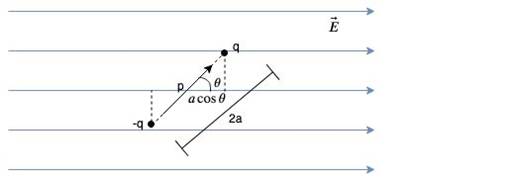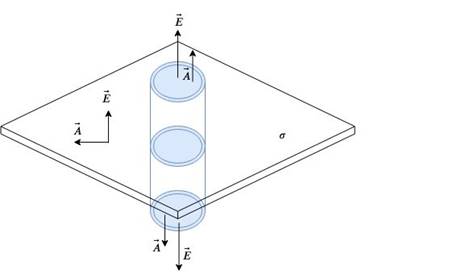(a) Derive the expression for the potential energy of an electric dipole of dipole moment ![]() placed in a uniform electric field
placed in a uniform electric field ![]() .
.
Find out the orientation of the dipole when it is in (i) stable equilibrium, (ii) unstable equilibrium.
(b) Figure shows a configuration of the charge array of two dipoles. Obtain the expression for the dependence of potential on r for r >> a for a point P on the axis of this array of charges.
OR
(a)Define electric flux. Write its S.I. unit.
(b)Using Gauss’s law, obtain the electric flux due to a point charge ‘q’ enclosed in a cube of side ‘a’.
(c)Show that the electric field due to a uniformly charged infinite plane sheet at any point distant x from it, is independent of x.
(a) The following figure shows an electric dipole with charges ![]() and
and ![]() separated by a distance
separated by a distance ![]() in a electric field
in a electric field ![]() .
.
The dipole moment is given by ![]()

Now, the torque on the dipole is
![]()
Therefore, work done by this torque in rotating the dipole is
![]()
![]()
![]()
Now, let ![]() and
and ![]()
![]()
Now, for stable equilibrium, ![]()
And unstable equilibrium gives ![]()
(b) From the figure it is evident that the potential at point P is due to three charges.
![]()
Where potential is given by ![]() where
where ![]() , q is the charge and r is the distance of the point from the charge.
, q is the charge and r is the distance of the point from the charge.
![]()
![]()
Now for ![]()
![]()
OR
(a) Electric flux is the amount of electric field crossing a given area or the integral of electric field over a given surface. Mathematically,
![]()
(b) The gauss law states that the total flux crossing a surface is directly proportional to the amount of electric charge held within the surface.
![]()
Here, the charge enclosed by the cube is q. Therefore, the flux is
![]()
(c) To calculate flux, we create a hypothetical Gaussian pill box through the surface. The area of the face of the cylinder is ![]() while the electric field is
while the electric field is ![]() .
.

The area and the field are at right angles throughout the surface of the cylinders except the faces.
Hence in the curved surface area, the flux is ![]()
At either side, the flux is
![]()
Total flux thus becomes (due to the two surfaces)
![]()
![]()
![]()
So the electric field has no dependence on distance, and only depends on the charge density of the sheet.